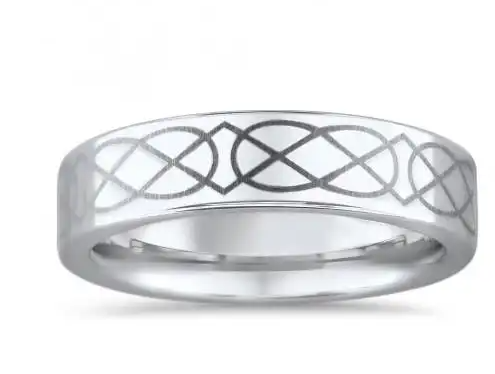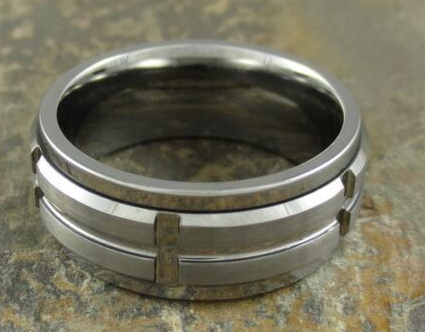Nine Tips To Grow Your Wedding Rings
페이지 정보
작성자 Francis 작성일 25-04-12 10:27 조회 32 댓글 0본문
Certainly! The process of recycling do tungsten rings tarnish carbide involves several steps to ensure the efficient recovery of tungsten and carbon, allowing for the creation of new products. Heres a detailed overview of the recycling process:
### 1. **Collection and Sorting**
- **Gathering Scrap**: Used tungsten carbide products, such as cutting tools, industrial machinery parts, and jewelry, are collected from various sources.
- **Sorting**: The collected materials are sorted to separate tungsten carbide from other metals and materials. This may involve manual sorting or automated systems.
### 2. **Processing**
- **Crushing**: The sorted tungsten carbide items are crushed into smaller pieces to facilitate further processing. This can be done using industrial crushers or grinders.
- **Grinding**: The crushed material is then ground into a fine powder. This step helps to liberate the tungsten carbide from any binding materials or contaminants.
### 3. **Separation**
- **Chemical or Physical Methods**: Various techniques can be used to separate tungsten carbide from impurities, such as metal alloys or non-carbide materials. Common methods include:
- **Magnetic Separation**: For materials containing ferrous metals.
- **Density Separation**: Using water or air to separate based on density differences.
- **Chemical Processes**: In some cases, chemical treatments might be used to dissolve impurities.
### 4. **Refinement**
- **Purification**: The separated tungsten carbide powder undergoes purification to remove any remaining contaminants and ensure high quality. This may include additional grinding and washing steps.
- **Sintering**: The purified tungsten ring with wood inlay carbide powder may be subjected to sintering, a process where it is heated to high temperatures in a controlled environment to form solid pieces.
### 5. **Manufacturing New Products**
- **Re-manufacturing**: The refined tungsten carbide powder can be used to create new tools and products. This includes:
- **Cutting Tools**: Drill bits, inserts, and other industrial cutting tools.
- **Jewelry**: New tungsten carbide rings and accessories.
- **Wear Parts**: Components for machinery that require high wear resistance.
### 6. **Quality Control**
- **Testing and Certification**: The recycled tungsten carbide products undergo quality control testing to ensure they meet industry standards for performance and durability.
### 7. **Distribution**
- **Market Supply**: Once the recycled products pass quality checks, they are distributed to manufacturers and retailers, re-entering the market as sustainable alternatives to new tungsten carbide products.
### Conclusion
The recycling of tungsten carbide is a multi-step process that involves collection, processing, separation, refinement, and re-manufacturing. This comprehensive approach not only conserves valuable resources but also reduces environmental impact, supporting sustainable practices in various industries. Through effective recycling, tungsten carbide can be repurposed into high-quality products, contributing to a circular economy.
 celtic tungsten made engraved LOVERS Romance Gifts celtic TUNGSTEN RINGS custom made women men carbide | Wedding bands
celtic tungsten made engraved LOVERS Romance Gifts celtic TUNGSTEN RINGS custom made women men carbide | Wedding bands
Certainly! The process of recycling tungsten carbide involves several steps to ensure the efficient recovery of tungsten and carbon, allowing for the creation of new products. Heres a detailed overview of the recycling process:
### 1. **Collection and Sorting**
- **Gathering Scrap**: Used tungsten carbide products, such as cutting tools, industrial machinery parts, and jewelry, are collected from various sources.
- **Sorting**: The collected materials are sorted to separate tungsten carbide from other metals and materials. This may involve manual sorting or automated systems.
### 2. **Processing**
- **Crushing**: The sorted tungsten carbide items are crushed into smaller pieces to facilitate further processing. This can be done using industrial crushers or grinders.
- **Grinding**: The crushed material is then ground into a fine powder. This step helps to liberate the tungsten carbide from any binding materials or contaminants.
### 3. **Separation**
- **Chemical or Physical Methods**: Various techniques can be used to separate tungsten carbide from impurities, such as metal alloys or non-carbide materials. Common methods include:
- **Magnetic Separation**: For materials containing ferrous metals.
- **Density Separation**: Using water or air to separate based on density differences.
- **Chemical Processes**: In some cases, chemical treatments might be used to dissolve impurities.
### 4. **Refinement**
- **Purification**: The separated tungsten carbide powder undergoes purification to remove any remaining contaminants and ensure high quality. This may include additional grinding and washing steps.
- **Sintering**: The purified tungsten carbide powder may be subjected to sintering, a process where it is heated to high temperatures in a controlled environment to form solid pieces.
### 5. **Manufacturing New Products**
- **Re-manufacturing**: The refined tungsten carbide powder can be used to create new tools and products. This includes:
- **Cutting Tools**: Drill bits, inserts, and other industrial cutting tools.
- **Jewelry**: New tungsten carbide rings and accessories.
- **Wear Parts**: Components for machinery that require high wear resistance.
### 6. **Quality Control**
- **Testing and Certification**: The recycled tungsten carbide products undergo quality control testing to ensure they meet industry standards for performance and durability.
### 7. **Distribution**
- **Market Supply**: Once the recycled products pass quality checks, they are distributed to manufacturers and retailers, re-entering the market as sustainable alternatives to new tungsten carbide products.
### Conclusion
The recycling of tungsten carbide is a multi-step process that involves collection, processing, separation, refinement, and re-manufacturing. This comprehensive approach not only conserves valuable resources but also reduces environmental impact, supporting sustainable practices in various industries. Through effective recycling, tungsten carbide can be repurposed into high-quality products, contributing to a circular economy.
 tungsten made engraved LOVERS Romance Gifts grooved TUNGSTEN RINGS custom made women men carbide | Wedding bands
tungsten made engraved LOVERS Romance Gifts grooved TUNGSTEN RINGS custom made women men carbide | Wedding bands
### 1. **Collection and Sorting**
- **Gathering Scrap**: Used tungsten carbide products, such as cutting tools, industrial machinery parts, and jewelry, are collected from various sources.
- **Sorting**: The collected materials are sorted to separate tungsten carbide from other metals and materials. This may involve manual sorting or automated systems.
### 2. **Processing**
- **Crushing**: The sorted tungsten carbide items are crushed into smaller pieces to facilitate further processing. This can be done using industrial crushers or grinders.
- **Grinding**: The crushed material is then ground into a fine powder. This step helps to liberate the tungsten carbide from any binding materials or contaminants.
### 3. **Separation**
- **Chemical or Physical Methods**: Various techniques can be used to separate tungsten carbide from impurities, such as metal alloys or non-carbide materials. Common methods include:
- **Magnetic Separation**: For materials containing ferrous metals.
- **Density Separation**: Using water or air to separate based on density differences.
- **Chemical Processes**: In some cases, chemical treatments might be used to dissolve impurities.
### 4. **Refinement**
- **Purification**: The separated tungsten carbide powder undergoes purification to remove any remaining contaminants and ensure high quality. This may include additional grinding and washing steps.
- **Sintering**: The purified tungsten ring with wood inlay carbide powder may be subjected to sintering, a process where it is heated to high temperatures in a controlled environment to form solid pieces.
### 5. **Manufacturing New Products**
- **Re-manufacturing**: The refined tungsten carbide powder can be used to create new tools and products. This includes:
- **Cutting Tools**: Drill bits, inserts, and other industrial cutting tools.
- **Jewelry**: New tungsten carbide rings and accessories.
- **Wear Parts**: Components for machinery that require high wear resistance.
### 6. **Quality Control**
- **Testing and Certification**: The recycled tungsten carbide products undergo quality control testing to ensure they meet industry standards for performance and durability.
### 7. **Distribution**
- **Market Supply**: Once the recycled products pass quality checks, they are distributed to manufacturers and retailers, re-entering the market as sustainable alternatives to new tungsten carbide products.
### Conclusion
The recycling of tungsten carbide is a multi-step process that involves collection, processing, separation, refinement, and re-manufacturing. This comprehensive approach not only conserves valuable resources but also reduces environmental impact, supporting sustainable practices in various industries. Through effective recycling, tungsten carbide can be repurposed into high-quality products, contributing to a circular economy.
 celtic tungsten made engraved LOVERS Romance Gifts celtic TUNGSTEN RINGS custom made women men carbide | Wedding bands
celtic tungsten made engraved LOVERS Romance Gifts celtic TUNGSTEN RINGS custom made women men carbide | Wedding bandsCertainly! The process of recycling tungsten carbide involves several steps to ensure the efficient recovery of tungsten and carbon, allowing for the creation of new products. Heres a detailed overview of the recycling process:
### 1. **Collection and Sorting**
- **Gathering Scrap**: Used tungsten carbide products, such as cutting tools, industrial machinery parts, and jewelry, are collected from various sources.
- **Sorting**: The collected materials are sorted to separate tungsten carbide from other metals and materials. This may involve manual sorting or automated systems.
### 2. **Processing**
- **Crushing**: The sorted tungsten carbide items are crushed into smaller pieces to facilitate further processing. This can be done using industrial crushers or grinders.
- **Grinding**: The crushed material is then ground into a fine powder. This step helps to liberate the tungsten carbide from any binding materials or contaminants.
### 3. **Separation**
- **Chemical or Physical Methods**: Various techniques can be used to separate tungsten carbide from impurities, such as metal alloys or non-carbide materials. Common methods include:
- **Magnetic Separation**: For materials containing ferrous metals.
- **Density Separation**: Using water or air to separate based on density differences.
- **Chemical Processes**: In some cases, chemical treatments might be used to dissolve impurities.
### 4. **Refinement**
- **Purification**: The separated tungsten carbide powder undergoes purification to remove any remaining contaminants and ensure high quality. This may include additional grinding and washing steps.
- **Sintering**: The purified tungsten carbide powder may be subjected to sintering, a process where it is heated to high temperatures in a controlled environment to form solid pieces.
### 5. **Manufacturing New Products**
- **Re-manufacturing**: The refined tungsten carbide powder can be used to create new tools and products. This includes:
- **Cutting Tools**: Drill bits, inserts, and other industrial cutting tools.
- **Jewelry**: New tungsten carbide rings and accessories.
- **Wear Parts**: Components for machinery that require high wear resistance.
### 6. **Quality Control**
- **Testing and Certification**: The recycled tungsten carbide products undergo quality control testing to ensure they meet industry standards for performance and durability.
### 7. **Distribution**
- **Market Supply**: Once the recycled products pass quality checks, they are distributed to manufacturers and retailers, re-entering the market as sustainable alternatives to new tungsten carbide products.
### Conclusion
The recycling of tungsten carbide is a multi-step process that involves collection, processing, separation, refinement, and re-manufacturing. This comprehensive approach not only conserves valuable resources but also reduces environmental impact, supporting sustainable practices in various industries. Through effective recycling, tungsten carbide can be repurposed into high-quality products, contributing to a circular economy.
 tungsten made engraved LOVERS Romance Gifts grooved TUNGSTEN RINGS custom made women men carbide | Wedding bands
tungsten made engraved LOVERS Romance Gifts grooved TUNGSTEN RINGS custom made women men carbide | Wedding bands댓글목록 0
등록된 댓글이 없습니다.
